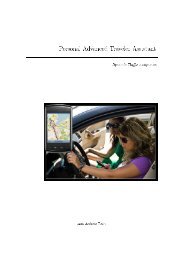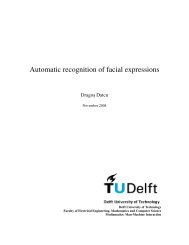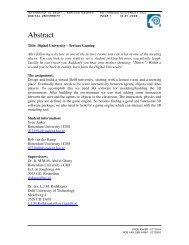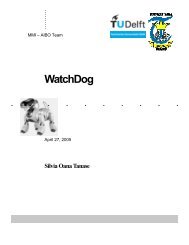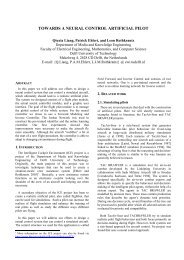Reasoning with uncertainty in the situational awareness of air targets
Reasoning with uncertainty in the situational awareness of air targets
Reasoning with uncertainty in the situational awareness of air targets
Create successful ePaper yourself
Turn your PDF publications into a flip-book with our unique Google optimized e-Paper software.
1<br />
<strong>Reason<strong>in</strong>g</strong> <strong>with</strong> <strong>uncerta<strong>in</strong>ty</strong> <strong>in</strong> <strong>the</strong> <strong>situational</strong><br />
<strong>awareness</strong> <strong>of</strong> <strong>air</strong> <strong>targets</strong><br />
LTZE2 B.G.M.Mertens 1,2 ,Dr.drs.L.J.M.Rothkrantz 1 ,Pr<strong>of</strong>.dr.ir.F.G.J.Absil 2 ,KLTZEir.F.Bolderheij 2<br />
Delft University <strong>of</strong> Technology 1<br />
Royal Ne<strong>the</strong>rlands Naval College 2<br />
Abstract— In combat simulations target classification and identification<br />
are very important. In this research area several studies<br />
about simulat<strong>in</strong>g identification have been done, most <strong>of</strong> <strong>the</strong>m take<br />
a set <strong>of</strong> <strong>in</strong>formation like “<strong>the</strong> target is visually identified hostile”<br />
to start <strong>the</strong> simulation <strong>with</strong>. Mostly classification is not taken<br />
<strong>in</strong>to account <strong>in</strong> identification problems.<br />
In this paper <strong>the</strong> <strong>in</strong>put consists <strong>of</strong> basic sensor data and a<br />
priori knowledge. This will be comb<strong>in</strong>ed <strong>in</strong>to <strong>in</strong>formation which<br />
is necessary to evaluate <strong>the</strong> situation. Based on this <strong>in</strong>formation<br />
<strong>the</strong> complete <strong>situational</strong> <strong>awareness</strong> is evaluated.<br />
To derive <strong>in</strong>formation out <strong>of</strong> data, facts have to be derived<br />
<strong>in</strong>to three areas, <strong>the</strong>se are facts concern<strong>in</strong>g position, identity and<br />
behaviour. Based on <strong>the</strong>se derived facts a decision will be made<br />
about <strong>the</strong> classification and <strong>the</strong> identification <strong>of</strong> <strong>the</strong> target.<br />
Two Bayesian reason<strong>in</strong>g models were designed for <strong>the</strong> decision<br />
processes <strong>of</strong> <strong>the</strong> target’s classification and identification. These<br />
models are designed as much alike as possible. An implementation<br />
was made to test <strong>the</strong> models. In <strong>the</strong> implementation temporal<br />
aspects are not taken <strong>in</strong>to account but <strong>the</strong> results were promis<strong>in</strong>g.<br />
To conclude we conducted a literature survey to <strong>in</strong>vestigate<br />
<strong>the</strong> possibilities <strong>of</strong> temporal reason<strong>in</strong>g <strong>in</strong> this project.<br />
Fig. 1.<br />
<strong>in</strong>put<br />
Mission<br />
rules<br />
<strong>in</strong>formation<br />
Environment<br />
Threat<br />
output<br />
Sensor<br />
Information<br />
ROE<br />
Authorities<br />
IDCRITS<br />
EMCON<br />
Ship<br />
ROE 230-232<br />
Identity<br />
ROE 420-427<br />
Overview <strong>of</strong> <strong>the</strong> situation on board combat vessels<br />
Operator<br />
Information<br />
Attack?<br />
Index Terms— Classification, Identification, DBN, BBN, <strong>Reason<strong>in</strong>g</strong>,<br />
Dempster-Shafer, <strong>air</strong> <strong>targets</strong>.<br />
I. INTRODUCTION<br />
On board a combat vessel a clear picture <strong>of</strong> all surround<strong>in</strong>g<br />
<strong>targets</strong> is essential. Therefore a team <strong>of</strong> experts evaluates all<br />
<strong>in</strong>formation ga<strong>the</strong>red by sensors on board <strong>the</strong> vessel and data<br />
communication <strong>with</strong> allied forces. In <strong>the</strong> evaluation process<br />
<strong>the</strong>y deal <strong>with</strong> a lot <strong>of</strong> <strong>uncerta<strong>in</strong>ty</strong>, this <strong>uncerta<strong>in</strong>ty</strong> has to<br />
be modeled [8] and [9]. Based on this <strong>in</strong>formation toge<strong>the</strong>r<br />
<strong>with</strong> guidel<strong>in</strong>es and rules supplied by <strong>the</strong> government (rules<br />
<strong>of</strong> engagement - ROE) a decision is made on several topics<br />
for each target. These topics are classification, identification<br />
and attack-decision evaluation. In <strong>the</strong> classification <strong>the</strong> target<br />
type is specified, <strong>in</strong> <strong>the</strong> identification <strong>the</strong> model determ<strong>in</strong>es<br />
whe<strong>the</strong>r <strong>the</strong> target is a friend or a foe.<br />
In a combat it is <strong>of</strong> great importance to have a reliable<br />
classification and identification process. In this paper a classification<br />
and identification system is presented which is based<br />
on expert knowledge and strict rules and is tested us<strong>in</strong>g a<br />
modeled environment.<br />
The complete system consists <strong>of</strong> three parts, first all necessary<br />
<strong>in</strong>formation is ga<strong>the</strong>red, <strong>the</strong>n as much facts as possible<br />
are derived and to conclude a decision is made for <strong>the</strong><br />
classification and identification <strong>of</strong> <strong>the</strong> target based on <strong>the</strong><br />
derived facts, us<strong>in</strong>g a Bayesian belief network [2]. These three<br />
parts are shown <strong>in</strong> Figure 2 and will be worked out <strong>in</strong> <strong>the</strong><br />
follow<strong>in</strong>g sections.<br />
Fig. 2.<br />
XML<br />
sensor<br />
<strong>in</strong>put<br />
pre-process<strong>in</strong>g<br />
BBN<br />
XML BBN<br />
specification<br />
<strong>in</strong>put pre-process<strong>in</strong>g reason<strong>in</strong>g process<br />
Overview <strong>of</strong> <strong>the</strong> entire system<br />
II. INPUT<br />
classification<br />
identification<br />
The <strong>in</strong>put is an XML file which conta<strong>in</strong>s for each target<br />
all available sensor data at different timepo<strong>in</strong>ts, toge<strong>the</strong>r <strong>with</strong><br />
a priori knowledge. This file is generated by a simulation<br />
developed <strong>in</strong> <strong>the</strong> STATOR project at <strong>the</strong> Royal Ne<strong>the</strong>rlands<br />
Naval College. This file conta<strong>in</strong>s <strong>in</strong>formation about:<br />
• Target track;<br />
• IFF on board?<br />
• IFF mode;<br />
• Vesta on board?<br />
• L<strong>in</strong>k 11 on board?<br />
• ESM signature;<br />
• Situational a priori <strong>in</strong>formation.
2<br />
III. PRE-PROCESSING<br />
In <strong>the</strong> real situation <strong>the</strong> decision mak<strong>in</strong>g process is done<br />
by humans, <strong>the</strong>y are experts <strong>in</strong> deriv<strong>in</strong>g facts from given<br />
<strong>in</strong>formation. In our model rules are necessary to do <strong>the</strong> same.<br />
Not all <strong>in</strong>formation which is necessary for <strong>the</strong> classification<br />
and identification <strong>of</strong> a target is directly given by <strong>the</strong> sensors.<br />
Sensors give basic <strong>in</strong>formation like <strong>the</strong> <strong>in</strong>put given to this<br />
system.<br />
We want to derive facts out <strong>of</strong> this basic <strong>in</strong>put by comb<strong>in</strong><strong>in</strong>g<br />
this <strong>in</strong>formation <strong>in</strong> <strong>the</strong> right way toge<strong>the</strong>r <strong>with</strong> a-priori<br />
knowledge. We want to divide <strong>the</strong>se facts <strong>in</strong>to three types,<br />
facts concern<strong>in</strong>g position, facts concern<strong>in</strong>g identity and facts<br />
concern<strong>in</strong>g behaviour:<br />
a) Concern<strong>in</strong>g <strong>the</strong> position:<br />
• Adherence to <strong>air</strong>lane<br />
• Adherence to <strong>air</strong> co-ord<strong>in</strong>ation order(ACO);<br />
• In military speed/altitude doma<strong>in</strong>;<br />
• Fly<strong>in</strong>g <strong>in</strong> formation;<br />
• Manoeuvr<strong>in</strong>g;<br />
• Inside identification safety range (ISR).<br />
b) Concern<strong>in</strong>g <strong>the</strong> identification:<br />
• Visual identification friendly/hostile;<br />
• ESM friendly/hostile;<br />
• IFF.<br />
c) Concern<strong>in</strong>g behaviour evaluation:<br />
• Hostile act;<br />
• Hostile <strong>in</strong>tent;<br />
• Performs identification.<br />
IV. REASONING<br />
The reason<strong>in</strong>g model is split up <strong>in</strong> two divisions, classification<br />
and identification. The model<strong>in</strong>g is done <strong>in</strong> two steps,<br />
first a global overview <strong>of</strong> <strong>the</strong> reason<strong>in</strong>g processes is given,<br />
followed by a detailed reason<strong>in</strong>g model us<strong>in</strong>g Bayesian belief<br />
networks.<br />
rules<br />
Fig. 4.<br />
Fig. 5.<br />
sensor<br />
<strong>in</strong>formation<br />
comparison<br />
belief<br />
facts<br />
classification<br />
IDCRITS<br />
output<br />
ROE<br />
check<br />
An overview <strong>of</strong> <strong>the</strong> identification reason<strong>in</strong>g process<br />
weapon carrier<br />
<strong>air</strong><br />
weapon<br />
conclusion<br />
fighter patrol<br />
helicopter TBM highdiver<br />
seaskimmer<br />
Classification<br />
target<br />
surface<br />
or a weapon carrier. And f<strong>in</strong>ally we determ<strong>in</strong>e what k<strong>in</strong>d <strong>of</strong><br />
weapon or weapon carrier <strong>the</strong> target might be.<br />
The Bayesian belief networks for <strong>the</strong> different layers use<br />
facts that can be used to dist<strong>in</strong>guish between <strong>the</strong> different<br />
groups. Information about <strong>the</strong>se dist<strong>in</strong>guish<strong>in</strong>g features were<br />
ga<strong>the</strong>red by <strong>in</strong>terview<strong>in</strong>g experts at <strong>the</strong> OPSCHOOL (operational<br />
school). In Figures 6 one <strong>of</strong> <strong>the</strong> Bayesian belief<br />
networks for <strong>the</strong> first layer is given. The numbers displayed<br />
<strong>in</strong> <strong>the</strong> figures are ga<strong>the</strong>red by <strong>in</strong>terview<strong>in</strong>g several experts at<br />
<strong>the</strong> OPSCHOOL. The <strong>in</strong>terviewed experts gave similar beliefs<br />
to <strong>the</strong> same relations, <strong>the</strong>se answers were comb<strong>in</strong>ed <strong>in</strong>to <strong>the</strong><br />
used values. The <strong>in</strong>formation is comb<strong>in</strong>ed us<strong>in</strong>g noisy and and<br />
noisy or gates [6].<br />
sensor<br />
<strong>in</strong>formation<br />
speed > 100<br />
kts<br />
altitude > 0<br />
0.8<br />
<strong>air</strong> target<br />
0.95<br />
noisy or<br />
rules<br />
comparison<br />
facts<br />
belief<br />
classification<br />
output<br />
level check<br />
conclusion<br />
Fig. 6.<br />
Bayesian belief model <strong>of</strong> an <strong>air</strong> target<br />
Fig. 3.<br />
rules<br />
An overview <strong>of</strong> <strong>the</strong> classification reason<strong>in</strong>g process<br />
In Figure 6 we can see that <strong>the</strong> speed and altitude are<br />
dist<strong>in</strong>guish<strong>in</strong>g features for an <strong>air</strong> target. In Figure 7 we can<br />
see that more <strong>in</strong>formation is needed <strong>in</strong> <strong>the</strong> network to decide<br />
whe<strong>the</strong>r <strong>the</strong> target is a weapon carrier or a weapon, than to<br />
decide whe<strong>the</strong>r <strong>the</strong> target is an <strong>air</strong> or a surface target.<br />
A. Classification<br />
The classification is done <strong>in</strong> three layers us<strong>in</strong>g iterative<br />
deepen<strong>in</strong>g. This can be seen <strong>in</strong> Figure 5. First we determ<strong>in</strong>e<br />
if <strong>the</strong> target is most likely an <strong>air</strong> target or a surface target. If<br />
<strong>the</strong> probability <strong>of</strong> an <strong>air</strong> target is <strong>the</strong> highest we search <strong>in</strong> that<br />
branch <strong>of</strong> <strong>the</strong> tree and exam<strong>in</strong>e whe<strong>the</strong>r <strong>the</strong> target is a weapon<br />
B. Identification<br />
Identification is done similar to <strong>the</strong> classification process but<br />
we have just one layer <strong>with</strong> 6 mutually exclusive decisions.<br />
Before we have any <strong>in</strong>formation about <strong>the</strong> target we identify<br />
<strong>the</strong> target as unknown, this identity is kept until we receive<br />
enough <strong>in</strong>formation to identify <strong>the</strong> target <strong>with</strong> one <strong>of</strong> <strong>the</strong><br />
follow<strong>in</strong>g 5 identities. A target can get 3 real identifications:
3<br />
IFF<br />
Vesta ESM plane<br />
0.95<br />
0.6<br />
0.95<br />
0 kts < altitude < 20<br />
velocity <<br />
kft<br />
160 kts<br />
0.8<br />
0.8<br />
noisy and<br />
helicopter<br />
doma<strong>in</strong><br />
TargetInfoFrame<br />
L<strong>in</strong>k<br />
0.95<br />
0.9<br />
manoeuvr<strong>in</strong>g<br />
¬ ISR<br />
ManagerFrame<br />
ClassificationFrame<br />
noisy or<br />
<strong>air</strong> target<br />
¬ weapon<br />
evidence<br />
weapon<br />
carrier<br />
evidence<br />
<strong>in</strong> formation<br />
0.7<br />
0.7<br />
far<br />
manoeuvr<strong>in</strong>g<br />
patrol<br />
doma<strong>in</strong><br />
0.6<br />
0.8<br />
noisy and<br />
0.8<br />
0.8<br />
noisy and<br />
5 kft <<br />
altitude < 40<br />
kft<br />
230 kts <<br />
velocity <<br />
500 kts<br />
OverviewGraphNode<br />
ClassificationGraphPanel<br />
weapon<br />
carrier<br />
noisy and<br />
noisy or<br />
0.6<br />
fighter<br />
doma<strong>in</strong><br />
0.8<br />
500 kts <<br />
velocity <<br />
mach 2.5<br />
noisy and<br />
0.8<br />
velocity ><br />
mach 6<br />
InferenceGraphNode<br />
(from InferenceGraphs)<br />
TargetPanel<br />
Fig. 7.<br />
Bayesian belief model <strong>of</strong> a weapon carrier<br />
TargetChang<br />
edListener<br />
friendly, neutral or hostile. But before we are able to identify<br />
<strong>the</strong> target def<strong>in</strong>itely we can assign pend<strong>in</strong>g identities to <strong>the</strong><br />
target: assumed friendly and suspect. In Figure 8 we see that<br />
a lot <strong>of</strong> <strong>in</strong>formation is needed to get an identity for a target.<br />
All facts <strong>in</strong> <strong>the</strong> figure re<strong>in</strong>force <strong>the</strong> belief <strong>of</strong> <strong>the</strong> target be<strong>in</strong>g<br />
a suspect target.<br />
Fig. 9.<br />
Class diagram <strong>of</strong> <strong>the</strong> gui<br />
Classifier<br />
Identifier<br />
SituationParser<br />
<strong>in</strong> military<br />
doma<strong>in</strong><br />
<strong>in</strong> formation manoeuvr<strong>in</strong>g<br />
0.5<br />
0.5<br />
0.5<br />
noisy or<br />
¬ ACO<br />
BayesianBeliefNetwork<br />
Manager<br />
FactsProcessor<br />
action<br />
0.75<br />
outside ISR<br />
1<br />
1<br />
behaviour<br />
0.8<br />
noisy and<br />
noisy and<br />
InferenceGraph<br />
(from InferenceGraphs)<br />
ProcessWorker<br />
visual<br />
¬ friendly<br />
classification far behaviour<br />
0.8 1<br />
ID authority<br />
ExceptionHandler<br />
unique<br />
¬ friendly<br />
ESM<br />
0.25<br />
0.25<br />
0.9<br />
Fig. 10.<br />
Class diagram <strong>of</strong> <strong>the</strong> ma<strong>in</strong> model<br />
noisy or<br />
Fig. 8.<br />
Suspect<br />
ID Suspect<br />
Bayesian belief model <strong>of</strong> a suspect target<br />
V. SYSTEM<br />
Based on <strong>the</strong> set <strong>of</strong> rules and <strong>the</strong> reason<strong>in</strong>g models for<br />
<strong>the</strong> classification and identification <strong>the</strong> complete system was<br />
implemented us<strong>in</strong>g JAVA. The class diagrams <strong>of</strong> <strong>the</strong> user<br />
<strong>in</strong>terface and <strong>the</strong> ma<strong>in</strong> model can be found <strong>in</strong> Figure 9 and<br />
10.<br />
A full class diagram may be difficult to <strong>in</strong>terpret because<br />
it gives a lot <strong>of</strong> <strong>in</strong>formation about <strong>the</strong> contents <strong>of</strong> <strong>the</strong> classes<br />
from which <strong>the</strong> functionality <strong>of</strong> <strong>the</strong> class is not directly evident.<br />
Therefore a class diagram <strong>with</strong> empty classes is created. Also<br />
some Class, Responsibility and Collaboration (CRC) cards that<br />
describe <strong>the</strong> responsibilities <strong>of</strong> <strong>the</strong> classes <strong>in</strong> natural language<br />
have been created. These CRC-cards can be seen <strong>in</strong> Figures<br />
11.<br />
Now we know <strong>the</strong> overall structure <strong>of</strong> <strong>the</strong> system we take<br />
a new look at <strong>the</strong> <strong>in</strong>put. The <strong>in</strong>put is an XML file which<br />
conta<strong>in</strong>s all available <strong>in</strong>formation at different timepo<strong>in</strong>ts. In<br />
<strong>the</strong> Target Identification and Classification (TIC) program we<br />
implemented <strong>the</strong> rule base and <strong>the</strong> Bayesian belief networks.<br />
These are ord<strong>in</strong>ary Bayesian belief models <strong>with</strong>out a temporal<br />
aspect. The temporal aspects are discussed <strong>in</strong> <strong>the</strong> next section,<br />
but we first wanted to exam<strong>in</strong>e <strong>the</strong> models <strong>in</strong> a simple way and<br />
if <strong>the</strong>y work <strong>the</strong> temporal relations can be added afterward.<br />
The program makes a decision for each timepo<strong>in</strong>t <strong>in</strong>dependently<br />
based on <strong>the</strong> sensor data available at that timepo<strong>in</strong>t. By<br />
look<strong>in</strong>g at <strong>the</strong> decisions <strong>in</strong> time we might already see some<br />
temporal relations.<br />
VI. TEMPORAL ASPECTS<br />
There are a couple <strong>of</strong> processes <strong>in</strong> which temporal reason<strong>in</strong>g<br />
may <strong>of</strong>fer additional <strong>in</strong>formation. These processes are:<br />
• Gett<strong>in</strong>g sensor data;<br />
• Deriv<strong>in</strong>g <strong>in</strong>formation;
4<br />
Manager<br />
Responsibility<br />
This class updates all <strong>the</strong> <br />
<strong>in</strong>formation about <strong>the</strong> target.<br />
Collaborators<br />
SituationParser <br />
FactsProcessor <br />
Classifier<br />
<br />
Identifier <br />
BayesianBeliefNetwork <br />
ProcessWorker <br />
SituationParser<br />
Responsibility<br />
Collaborators<br />
This class parses all necessary <br />
values out <strong>of</strong> an XML file. Values <br />
that are not available are if possible <br />
replaced by <strong>in</strong>itial values. <br />
FactsProcessor<br />
Responsibility<br />
Collaborators<br />
This class derives per target facts BayesianBeliefNetwork <br />
from <strong>the</strong> <strong>in</strong>formation ga<strong>the</strong>red by SituationParser<br />
<strong>the</strong> SituationParser. <br />
ProcessWorker<br />
Responsibility<br />
Collaborators<br />
This class updates all nescessary Classifier<br />
<strong>in</strong>formation for <strong>the</strong> classification Identifier<br />
and <strong>in</strong>dentification <strong>of</strong> <strong>the</strong> target. ManagerFrame <br />
FactsProcessor<br />
BayesianBeliefNetwork<br />
Responsibility<br />
Collaborators<br />
This class adds <strong>in</strong>formation to <strong>the</strong> InferenceGraphNode<br />
Bayesian belief network and reads <br />
<strong>in</strong>formation out <strong>of</strong> <strong>the</strong> bayesian <br />
belief network.<br />
Classifier<br />
Responsibility<br />
Collaborators<br />
This class comb<strong>in</strong>es all available BayesianBeliefNetwork<br />
<strong>in</strong>fluenc<strong>in</strong>g facts <strong>in</strong>to a conclusion <br />
about <strong>the</strong> target's classification.<br />
Identifier<br />
Responsibility<br />
Collaborators<br />
This class comb<strong>in</strong>es all available BayesianBeliefNetwork <br />
<strong>in</strong>fluenc<strong>in</strong>g facts <strong>in</strong>to a conclusion Classifier<br />
about <strong>the</strong> target's identification<br />
ManagerFrame<br />
Responsibility<br />
Collaborators<br />
This class manages all possible Manager<br />
actions <strong>in</strong> <strong>the</strong> user <strong>in</strong>terface.<br />
InferenceGraphNode<br />
Responsibility<br />
Collaborators<br />
This class represents a node <strong>in</strong> <strong>the</strong> <br />
Bayesian belief network<br />
ExceptionHandler<br />
Responsibility<br />
This class handles exceptions<br />
Fig. 11.<br />
The CRC cards<br />
Collaborators<br />
• Decision mak<strong>in</strong>g.<br />
<br />
<br />
The benefits and problems <strong>of</strong> temporal reason<strong>in</strong>g <strong>in</strong> <strong>the</strong>se<br />
processes are evaluated.<br />
First <strong>the</strong> sensor <strong>in</strong>formation, <strong>in</strong> a lot <strong>of</strong> civil situations it is<br />
obvious that sensor <strong>in</strong>formation will give <strong>in</strong>formation about <strong>the</strong><br />
target. At an <strong>air</strong>port for example, <strong>the</strong> <strong>in</strong>com<strong>in</strong>g planes would<br />
like <strong>the</strong> <strong>air</strong> traffic controller to know exactly what k<strong>in</strong>d <strong>of</strong> plane<br />
is com<strong>in</strong>g and <strong>in</strong> which position <strong>the</strong> plane is at <strong>the</strong> moment.<br />
Because <strong>the</strong>re is a limited set <strong>of</strong> possible approaches to each<br />
land<strong>in</strong>g strip we expect to see a pattern <strong>in</strong> <strong>the</strong> sensor read<strong>in</strong>gs.<br />
While <strong>the</strong> plane is com<strong>in</strong>g closer more detailed <strong>in</strong>formation<br />
can be given and one <strong>of</strong> <strong>the</strong> approaches gets more probable<br />
<strong>in</strong> time. In military situations we expect a little different<br />
situation. In a military environment we expect very limited<br />
<strong>in</strong>formation about approach<strong>in</strong>g <strong>targets</strong>. Hostile forces will try<br />
to give as little <strong>in</strong>formation as possible about <strong>the</strong>mselves<br />
and sometimes try to give false <strong>in</strong>formation to mislead <strong>the</strong>ir<br />
opponents. Fur<strong>the</strong>rmore as long as we do not know what k<strong>in</strong>d<br />
<strong>of</strong> target is approach<strong>in</strong>g <strong>the</strong>re are no strict rules about how <strong>the</strong><br />
target will approach for example. So sensor read<strong>in</strong>gs will not<br />
be very predictable <strong>in</strong> time and temporal reason<strong>in</strong>g will not<br />
add much <strong>in</strong>formation <strong>in</strong> this process.<br />
Second <strong>the</strong> process <strong>of</strong> deriv<strong>in</strong>g and comb<strong>in</strong><strong>in</strong>g <strong>in</strong>formation.<br />
As expla<strong>in</strong>ed before sensor data can be used to obta<strong>in</strong> more<br />
detailed <strong>in</strong>formation. For example, <strong>the</strong> head<strong>in</strong>g and speed <strong>of</strong><br />
a target may be derived from positions <strong>of</strong> <strong>the</strong> target <strong>in</strong> time.<br />
Therefore we have to take a look at each derived fact and<br />
determ<strong>in</strong>e if it is possible to use temporal reason<strong>in</strong>g. Most<br />
<strong>of</strong> <strong>the</strong>se facts are partially related <strong>in</strong> time, but o<strong>the</strong>rs can’t<br />
be evaluated at one timepo<strong>in</strong>t, an example <strong>of</strong> such a fact<br />
is manoeuvr<strong>in</strong>g. It is obvious that we are not able to tell<br />
whe<strong>the</strong>r a target is mov<strong>in</strong>g accord<strong>in</strong>g to one position. The<br />
partially temporal related facts become more certa<strong>in</strong> when <strong>the</strong>y<br />
occur <strong>of</strong>ten. F<strong>in</strong>ally <strong>the</strong>re are also some facts which can be<br />
derived from o<strong>the</strong>r facts <strong>in</strong> time, like <strong>the</strong> head<strong>in</strong>g and speed<br />
can be derived from <strong>the</strong> positions <strong>of</strong> a target <strong>in</strong> time, but<br />
which can also be obta<strong>in</strong>ed directly from <strong>the</strong> sensor data. This<br />
means that <strong>the</strong>se facts can also be derived if <strong>the</strong> sensors are<br />
malfunction<strong>in</strong>g or have been switched <strong>of</strong>f.<br />
The way a target moves (its behaviour) is <strong>the</strong> most dist<strong>in</strong>ctive<br />
feature between different sorts <strong>of</strong> <strong>targets</strong>. From <strong>the</strong> list<br />
above it shows that <strong>the</strong> behaviour <strong>of</strong> a target is time related,<br />
thus it may be useful to evaluate <strong>the</strong> behaviour <strong>in</strong> time.<br />
F<strong>in</strong>ally <strong>the</strong> decision mak<strong>in</strong>g, <strong>the</strong> decision will get more reliable<br />
<strong>in</strong> time because <strong>the</strong>re will be more <strong>in</strong>formation available<br />
when <strong>the</strong> target has been followed for some time or <strong>the</strong> target<br />
has come closer. The decision process will take care <strong>of</strong> <strong>the</strong><br />
process<strong>in</strong>g <strong>of</strong> this <strong>in</strong>formation <strong>in</strong>to a proper decision, <strong>in</strong> which<br />
<strong>the</strong> process could take <strong>the</strong> decision at an earlier time po<strong>in</strong>t <strong>in</strong>to<br />
account. In comparison to <strong>the</strong> benefits <strong>of</strong> temporal reason<strong>in</strong>g<br />
<strong>in</strong> <strong>the</strong> evaluation process <strong>the</strong> benefits <strong>in</strong> <strong>the</strong> decision process<br />
is expected to be quite small.<br />
To model <strong>the</strong>se temporal relations we could use dynamic<br />
Bayesian networks (DBN). DBN is a term which can be<br />
expla<strong>in</strong>ed <strong>in</strong> many different ways.<br />
1 Some say a dynamic Bayesian network is a network<br />
which is dynamic <strong>in</strong> time [7], so <strong>the</strong> actual structure <strong>of</strong><br />
<strong>the</strong> network may change over time.<br />
2 O<strong>the</strong>rs say a dynamic Bayesian network is a regular<br />
Bayesian network <strong>in</strong> which some nodes have connections<br />
to nodes <strong>in</strong> ano<strong>the</strong>r timeslice [1] and [4], as depicted <strong>in</strong><br />
Figure 12.<br />
3 Some state that a dynamic Bayesian network is a regular<br />
Bayesian network where some nodes have a temporal<br />
character [5] see Figure 13.<br />
Fig. 12.<br />
speed > 100<br />
kts<br />
<strong>air</strong> target<br />
t = 0<br />
altitude > 0<br />
speed > 100<br />
kts<br />
<strong>air</strong> target<br />
t = 1<br />
altitude > 0<br />
An example <strong>of</strong> <strong>in</strong>tertimeslice connections <strong>in</strong> a DBN<br />
The last two explanations can directly be projected <strong>in</strong>to our<br />
model. If we take ano<strong>the</strong>r look at <strong>the</strong> first part <strong>of</strong> this section<br />
we learn that <strong>the</strong>se two sorts <strong>of</strong> temporal relations are seen<br />
frequently. As an example <strong>of</strong> <strong>the</strong> first: if an altitude is measured<br />
once we can say that <strong>in</strong> <strong>the</strong> next time slice it is very well<br />
possible that <strong>the</strong> target has approximately <strong>the</strong> same altitude<br />
aga<strong>in</strong> and will still be an <strong>air</strong> target. As an example <strong>of</strong> <strong>the</strong><br />
second temporal <strong>in</strong>formation like <strong>the</strong> target is manoeuvr<strong>in</strong>g is<br />
<strong>in</strong>jected <strong>in</strong>to a node.
5<br />
t=2<br />
t=0<br />
t=3<br />
t=1<br />
t=5<br />
0,8<br />
0,7<br />
Classification missilesite 1<br />
Seaskimmer<br />
Fighter<br />
Patrol<br />
Surface target<br />
TBM<br />
Helicopter<br />
Highdiver<br />
0,6<br />
t=4<br />
t=6<br />
far<br />
manoeuvr<strong>in</strong>g<br />
<strong>in</strong> formation<br />
etc.<br />
probability<br />
0,5<br />
0,4<br />
weapon<br />
carrier<br />
0,3<br />
0,2<br />
fighter target<br />
0,1<br />
fighter<br />
0<br />
1 2 3 4 5 6 7 8 9 10 11 12 13 14 15 16 17<br />
timepo<strong>in</strong>ts<br />
Fig. 13.<br />
An example <strong>of</strong> temporal <strong>in</strong>put <strong>in</strong> a DBN<br />
Fig. 14.<br />
site 1<br />
The probability distribution over <strong>the</strong> possible decisions for missile<br />
VII. RESULTS<br />
The system was tested by execut<strong>in</strong>g a scenario <strong>in</strong> which a<br />
ship may encounter all sorts <strong>of</strong> <strong>targets</strong> <strong>in</strong> a way that has been<br />
designed to test <strong>the</strong> program, to see if <strong>the</strong> program produces<br />
good results and satisfies its requirements. The scenarios that<br />
were used are described <strong>in</strong> Section VII-A, after which <strong>the</strong> test<br />
results are given and expla<strong>in</strong>ed <strong>in</strong> Section VII-B.<br />
A. The test scenario<br />
The model that was used <strong>in</strong> this test scenario was developed<br />
<strong>in</strong> <strong>the</strong> STATOR project at <strong>the</strong> Royal Ne<strong>the</strong>rlands Naval<br />
College. This program gives an XML file as output <strong>in</strong> which<br />
all <strong>in</strong>formation from <strong>the</strong> ship’s sensors about <strong>targets</strong> <strong>in</strong> <strong>the</strong><br />
neighbourhood are given.<br />
In this scenario a ship sails a certa<strong>in</strong> track <strong>in</strong> which some<br />
<strong>targets</strong> may approach <strong>the</strong> ship. In our scenario <strong>the</strong> ship first<br />
reaches a missile site which fires four sea skimm<strong>in</strong>g missiles,<br />
second <strong>the</strong> ship reaches a missile site which fires two sea<br />
skimm<strong>in</strong>g missiles <strong>with</strong> way po<strong>in</strong>ts and <strong>in</strong> <strong>the</strong> end an <strong>air</strong>l<strong>in</strong>er<br />
flies across <strong>the</strong> ship <strong>in</strong> an <strong>air</strong>lane. This will be split up <strong>in</strong> three<br />
separate scenario’s.<br />
seaskimm<strong>in</strong>g missile, <strong>in</strong> <strong>the</strong> second figure <strong>the</strong> radar is thought<br />
to be <strong>of</strong> a highdiv<strong>in</strong>g missile. In <strong>the</strong> last case <strong>the</strong>re is some<br />
conflict<strong>in</strong>g evidence, <strong>the</strong> target is mov<strong>in</strong>g <strong>with</strong> a velocity and<br />
<strong>in</strong> <strong>the</strong> altitude range <strong>of</strong> a seaskimm<strong>in</strong>g missile but regard<strong>in</strong>g<br />
<strong>the</strong> radar it could be a highdiv<strong>in</strong>g missile.<br />
In <strong>the</strong>se figures we see first two pop ups before we cont<strong>in</strong>uously<br />
detect <strong>the</strong> target, that is because <strong>of</strong> <strong>the</strong> sort <strong>of</strong> radar<br />
which is used. In this scenario we have a priori knowledge<br />
about <strong>the</strong> position <strong>of</strong> a missile site along <strong>the</strong> track. We expect<br />
a threat out <strong>of</strong> that direction and use a special radar to check<br />
for a longer range <strong>with</strong> smaller bundle <strong>in</strong> that direction once<br />
<strong>in</strong> a while. So we are able to detect <strong>the</strong> missiles before <strong>the</strong>y<br />
enter our <strong>air</strong> surveillance radar range.<br />
probability<br />
0,8<br />
0,7<br />
0,6<br />
0,5<br />
0,4<br />
0,3<br />
Classification Missilesite 2<br />
Seaskimmer<br />
Fighter<br />
Surface target<br />
Patrol<br />
TBM<br />
Highdiver<br />
Helicopter<br />
0,2<br />
B. The test results<br />
1) Scenario 1: The ship reaches <strong>the</strong> first missile site and<br />
encounters four seaskimm<strong>in</strong>g missiles. In Figure 14 <strong>the</strong> probability<br />
distribution <strong>in</strong> time can be seen. Here <strong>the</strong> first <strong>of</strong> four<br />
missiles is approach<strong>in</strong>g <strong>the</strong> ship. In <strong>the</strong> figure <strong>the</strong> evolution <strong>of</strong><br />
evidence <strong>in</strong> time can be seen, first <strong>the</strong> sensors give <strong>in</strong>formation<br />
about <strong>the</strong> altitude and velocity <strong>of</strong> <strong>the</strong> target. For <strong>the</strong> range <strong>of</strong><br />
altitude and velocity <strong>of</strong> this target <strong>the</strong>re are two sorts <strong>of</strong> <strong>targets</strong><br />
which are equally likely, namely a seaskimm<strong>in</strong>g missile and a<br />
fighter. The decision displayed will be <strong>air</strong>target, because <strong>the</strong><br />
probability <strong>of</strong> weapon and weapon carrier are equally likely<br />
too. Some time later, <strong>the</strong> target switches its radar on. This<br />
new <strong>in</strong>formation makes it possible to decide that <strong>the</strong> target is<br />
probably a seaskimm<strong>in</strong>g missile.<br />
2) Scenario 2: The ship reaches <strong>the</strong> second missile site<br />
and encounters two seaskimm<strong>in</strong>g missiles <strong>with</strong> waypo<strong>in</strong>ts <strong>in</strong><br />
<strong>the</strong>ir track. In Figures 15 and 16 <strong>the</strong> probability distribution<br />
<strong>in</strong> time can be seen. The difference between <strong>the</strong>se two figures<br />
is <strong>the</strong> database used to determ<strong>in</strong>e what platform may use <strong>the</strong><br />
detected radar. In <strong>the</strong> first figure <strong>the</strong> radar is thought to be <strong>of</strong> a<br />
0,1<br />
0<br />
Fig. 15.<br />
site 2<br />
1 2 3 4 5 6 7 8 9 10 11 12 13 14 15 16 17 18 19 20 21 22 23<br />
timepo<strong>in</strong>t<br />
The probability distribution over <strong>the</strong> possible decisions for missile<br />
3) Scenario 3: The ship encounters an <strong>air</strong>l<strong>in</strong>er which is<br />
fly<strong>in</strong>g <strong>in</strong> an <strong>air</strong>lane. The classification <strong>of</strong> this target can be seen<br />
<strong>in</strong> Figure 17. This <strong>air</strong>craft transmits an IFF signal <strong>in</strong> mode 3.<br />
This makes us able to identify <strong>the</strong> target this can be seen <strong>in</strong><br />
Figure 18. In <strong>the</strong> first two scenario’s we see no identification<br />
figures, because we are not able to identify a target based on<br />
velocity and altitude only.<br />
VIII. EVALUATION OF THE TEST RESULTS<br />
Dur<strong>in</strong>g <strong>the</strong> execution <strong>of</strong> <strong>the</strong> test scenario’s we realised that<br />
<strong>the</strong> TIC program was able to classify most <strong>of</strong> <strong>the</strong> <strong>targets</strong><br />
correctly if <strong>the</strong>re was enough <strong>in</strong>formation available. First we<br />
tested <strong>the</strong> program us<strong>in</strong>g <strong>the</strong> velocity, altitude and head<strong>in</strong>g <strong>of</strong><br />
each target. We saw that <strong>the</strong> program was not able to make
6<br />
0,7<br />
0,6<br />
Classification missilesite 2<br />
Fighter<br />
Seaskimmer<br />
Highdiver<br />
Surface target<br />
Helicopter<br />
TBM<br />
Patrol<br />
0,9<br />
0,8<br />
Identification Airplane<br />
Assumed friendly<br />
Neutral<br />
Suspect<br />
Hostile<br />
Friendly<br />
0,7<br />
0,5<br />
0,6<br />
probability<br />
0,4<br />
0,3<br />
probability<br />
0,5<br />
0,4<br />
0,2<br />
0,3<br />
0,2<br />
0,1<br />
0,1<br />
0<br />
15300<br />
15310<br />
15320<br />
15330<br />
15340<br />
15350<br />
15360<br />
15370<br />
15380<br />
15390<br />
15400<br />
15410<br />
15420<br />
15430<br />
15440<br />
15450<br />
15460<br />
15470<br />
15480<br />
15490<br />
15500<br />
15510<br />
0<br />
1 3 5 7 9 11 13 15 17 19 21 23 25 27 29 31 33 35 37 39 41 43 45 47 49 51 53 55 57 59 61 63 65 67 69 71<br />
timepo<strong>in</strong>ts<br />
timepo<strong>in</strong>t<br />
Fig. 16. The probability distribution over <strong>the</strong> possible decisions for missile<br />
site 2 <strong>with</strong> conflict<strong>in</strong>g evidence<br />
Fig. 18. The probability distribution over <strong>the</strong> possible identification decisions<br />
for <strong>the</strong> <strong>air</strong>plane<br />
Classification <strong>air</strong>plane<br />
Classification Missilesite 2<br />
Seaskimmer<br />
Fighter<br />
0,8<br />
0,8<br />
Surface target<br />
Patrol<br />
TBM<br />
0,7<br />
0,7<br />
Highdiver<br />
Helicopter<br />
0,6<br />
0,6<br />
probability<br />
0,5<br />
0,4<br />
0,3<br />
Surface target<br />
Helicopter<br />
Patrol<br />
Fighter<br />
TBM<br />
Highdiver<br />
Seaskimmer<br />
probability<br />
0,5<br />
0,4<br />
0,3<br />
0,2<br />
0,2<br />
0,1<br />
0,1<br />
0<br />
1 3 5 7 9 11 13 15 17 19 21 23 25 27 29 31 33 35 37 39 41 43 45 47 49 51 53 55 57 59 61 63 65 67 69 71<br />
timepo<strong>in</strong>t<br />
0<br />
1 2 3 4 5 6 7 8 9 10 11 12 13 14 15 16 17 18 19 20 21 22 23<br />
timepo<strong>in</strong>t<br />
Fig. 17. The probability distribution over <strong>the</strong> possible classification decisions<br />
for <strong>the</strong> <strong>air</strong>plane<br />
Fig. 19. The probability distribution over <strong>the</strong> possible decisions for missile<br />
site 2 <strong>with</strong> temporal relations<br />
a correct decision. Because <strong>the</strong> velocity and altitude doma<strong>in</strong><br />
<strong>of</strong> a fighter and a seaskimm<strong>in</strong>g missile are almost identical,<br />
<strong>the</strong> probabilities <strong>of</strong> both options become equal. The program<br />
decides <strong>with</strong> a maximum likelihood <strong>the</strong>orem, and <strong>the</strong>n displays<br />
<strong>the</strong> decision <strong>air</strong> target, because that is <strong>the</strong> only th<strong>in</strong>g that is<br />
certa<strong>in</strong>. If <strong>the</strong> program gets some more specific <strong>in</strong>formation<br />
like a radar that switches on dur<strong>in</strong>g <strong>the</strong> approach <strong>the</strong> program<br />
becomes able to draw <strong>the</strong> right conclusion. The same can be<br />
seen <strong>in</strong> <strong>the</strong> third scenario, <strong>the</strong> <strong>air</strong>l<strong>in</strong>er has a slightly higher<br />
velocity than we would expect <strong>of</strong> a patrol <strong>air</strong>craft so <strong>the</strong><br />
probability stays quite low. The decision is made based on<br />
<strong>the</strong> ESM signature which is obviously a civil one.<br />
It became clear that <strong>the</strong> identification needs more <strong>in</strong>formation<br />
than <strong>the</strong> classification to make a good decision. This could<br />
be directly deduced from <strong>the</strong> BBN. Therefore we only see a<br />
proper identification <strong>in</strong> <strong>the</strong> third scenario. In that case we have<br />
an IFF transmission and we know <strong>the</strong> target is fly<strong>in</strong>g <strong>in</strong> an<br />
<strong>air</strong>lane and we have an ESM signature <strong>of</strong> <strong>the</strong> target which is<br />
obviously a civil one. This leads to a neutral identity, because<br />
<strong>of</strong> <strong>the</strong> IFF mode 3 we see a lower probability for an assumed<br />
friendly identity.<br />
In <strong>the</strong> second scenario a number <strong>of</strong> situations occur where<br />
temporal reason<strong>in</strong>g could improve <strong>the</strong> results. We already discussed<br />
<strong>the</strong> first two peaks, but if we add <strong>the</strong> temporal relation<br />
that <strong>the</strong> belief is kept if no contradict<strong>in</strong>g new <strong>in</strong>formation is<br />
received, <strong>the</strong> figure would look smoo<strong>the</strong>r, we expect <strong>the</strong> figure<br />
to look like Figure 19 <strong>in</strong> stead <strong>of</strong> Figure 20.<br />
IX. CONCLUSION<br />
This paper shows that it is possible to design and implement<br />
a model that is able to make a decision about <strong>the</strong> classification<br />
and identification <strong>of</strong> an <strong>air</strong> target based on sensor data <strong>in</strong> a<br />
maritime environment.<br />
To improve <strong>the</strong> simulated decision process better knowledge<br />
about <strong>the</strong> way classification and identification is done on board<br />
combat vessels was necessary; this knowledge was ga<strong>the</strong>red<br />
at <strong>the</strong> OPSCHOOL. Fur<strong>the</strong>r <strong>in</strong>formation about how to model<br />
<strong>uncerta<strong>in</strong>ty</strong> was very important. A global study <strong>of</strong> <strong>the</strong> most<br />
common approaches showed Dempster-Shafer and Bayesian<br />
belief networks were promis<strong>in</strong>g possibilities. A deeper study<br />
<strong>in</strong>to <strong>the</strong>se two <strong>the</strong>orems showed Bayesian Belief Networks<br />
best for this problem. F<strong>in</strong>ally a study was done to <strong>in</strong>vestigate<br />
<strong>the</strong> possibilities <strong>of</strong> temporal reason<strong>in</strong>g <strong>in</strong> <strong>the</strong> model. The<br />
most commonly used methods were <strong>in</strong>vestigated and Dynamic<br />
Bayesian networks showed to be useful for this model.<br />
To design reliable Bayesian belief networks expert knowledge<br />
was necessary, which was aga<strong>in</strong> ga<strong>the</strong>red at <strong>the</strong> OP-<br />
SCHOOL. Based on this knowledge a system is designed<br />
which can be split <strong>in</strong>to two complement<strong>in</strong>g parts: <strong>the</strong> classification<br />
and <strong>the</strong> identification.<br />
The Bayesian belief models were implemented us<strong>in</strong>g JAVA.<br />
In this implementation <strong>the</strong> temporal aspect is not taken <strong>in</strong>to<br />
account. To test <strong>the</strong> models some challeng<strong>in</strong>g scenario’s were<br />
carried out. These tests show that for a proper classification<br />
<strong>of</strong> <strong>the</strong> target more <strong>in</strong>formation is needed than <strong>the</strong> velocity
7<br />
0,8<br />
0,7<br />
0,6<br />
Classification Missilesite 2<br />
Seaskimmer<br />
Fighter<br />
Surface target<br />
Patrol<br />
TBM<br />
Highdiver<br />
Helicopter<br />
[9] Voorbraak F., <strong>Reason<strong>in</strong>g</strong> <strong>with</strong> <strong>uncerta<strong>in</strong>ty</strong> <strong>in</strong> AI, <strong>Reason<strong>in</strong>g</strong> <strong>with</strong><br />
<strong>uncerta<strong>in</strong>ty</strong> <strong>in</strong> Robotics, Intern. Workshop proceed<strong>in</strong>gs, pages 52-<br />
90Department <strong>of</strong> Ma<strong>the</strong>matics, Computer Science, Physics and Astronomy,<br />
University <strong>of</strong> Amsterdam, (1995).<br />
0,5<br />
probability<br />
0,4<br />
0,3<br />
0,2<br />
0,1<br />
0<br />
1 2 3 4 5 6 7 8 9 10 11 12 13 14 15 16 17 18 19 20 21 22 23<br />
timepo<strong>in</strong>t<br />
Fig. 20. The probability distribution over <strong>the</strong> possible decisions for missile<br />
site 2 <strong>with</strong>out temporal relations<br />
and <strong>the</strong> altitude <strong>of</strong> <strong>the</strong> target. For <strong>the</strong> identification <strong>of</strong> a target<br />
even more complex <strong>in</strong>formation is needed about <strong>the</strong> target’s<br />
behaviour. These tests showed that temporal reason<strong>in</strong>g may<br />
have a smooth<strong>in</strong>g effect on <strong>the</strong> decision.<br />
It is important to build a prototype which takes <strong>the</strong> temporal<br />
aspects <strong>in</strong>to account and to perform tests to determ<strong>in</strong>e <strong>the</strong> real<br />
benefits <strong>of</strong> temporal reason<strong>in</strong>g.<br />
This model may be used <strong>in</strong> several applications:<br />
• In a naval combat simulation;<br />
• In a threat evaluation program;<br />
• As a decision support system on board combat vessels.<br />
For this last application some changes have to take place<br />
<strong>in</strong> <strong>the</strong> situation on board combat vessels. Most operators do<br />
not trust automatic systems. This model should be used as a<br />
support to make <strong>the</strong> right decision, not to make decisions on<br />
its own. But before <strong>the</strong> system is ready to be used <strong>in</strong> such a<br />
critical environment a lot <strong>of</strong> tests should be done to guarantee<br />
<strong>the</strong> reliability. In some cases <strong>the</strong> model might need some f<strong>in</strong>e<br />
tun<strong>in</strong>g.<br />
REFERENCES<br />
[1] Burns B. and Morrison C.T., Temporal Abstraction <strong>in</strong> Bayesian Networks,<br />
AAAI Spr<strong>in</strong>g Symposium, Palo Alto, California, (2003)<br />
[2] Cooper G., Probabilistic <strong>in</strong>ference us<strong>in</strong>g belief networks is NP-hard,<br />
Artificial Intelligence 42, 393-405, (1990).<br />
[3] Guo H. and Hsu W.H., A Survey <strong>of</strong> Algorithms for Real-Time Bayesian<br />
Network Inference, AAAI/KDD/UAI-2002, Jo<strong>in</strong>t Workshop on Real-<br />
Time Decision Support and Diagnostic Systems, Laboratory <strong>of</strong> Knowledge<br />
Discovery <strong>in</strong> Database Department <strong>of</strong> Comput<strong>in</strong>g and Information<br />
Sciences, Kansas State University, (July 2002).<br />
[4] Murphy K.P., Dynamic Bayesian Networks: Representation, Inference<br />
and Learn<strong>in</strong>g, University <strong>of</strong> California, Berkeley, (2002)<br />
[5] Nodelman U., Shelton C.R. and Koller D., Learn<strong>in</strong>g Cont<strong>in</strong>uous Time<br />
Bayesian Networks, Stanford University, Proceed<strong>in</strong>gs <strong>of</strong> <strong>the</strong> N<strong>in</strong>eteenth<br />
International Conference on Uncerta<strong>in</strong>ty <strong>in</strong> Artificial Intelligence, pp.<br />
451-458, (2003)<br />
[6] Parsons S., Bigham J., Possibility <strong>the</strong>ory and <strong>the</strong> generalised Noisy<br />
OR model, Department <strong>of</strong> Electronic Engeneer<strong>in</strong>g, Queen Mary and<br />
Westfield College.<br />
[7] Vladimir Pavlović V., Rehg J.M., and Cham T., A Dynamic Bayesian<br />
Network Approach to Track<strong>in</strong>g Us<strong>in</strong>g Learned Switch<strong>in</strong>g Dynamic<br />
Models, Compaq Computer Corporation Cambridge Research Lab.<br />
[8] Smets Ph., Imperfect Information: imprecision - <strong>uncerta<strong>in</strong>ty</strong>, Uncerta<strong>in</strong>ty<br />
Management <strong>in</strong> Information Systems. From Needs to Solutions. A.<br />
Motro and PH Smets, Kluwer Academic Publishers (1997), 225-254,<br />
Université Libre de Bruxelles, (July 1999).





